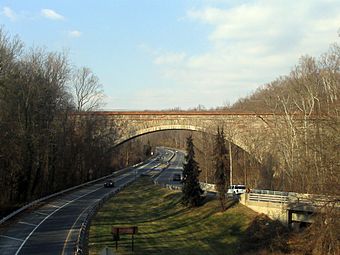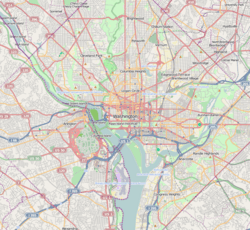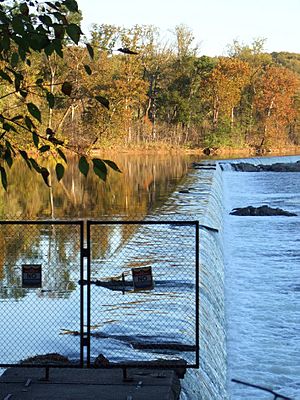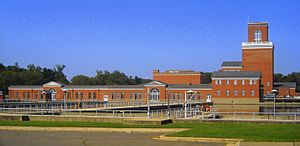Washington Aqueduct facts for kids
|
Washington Aqueduct
|
|

The Union Arch Bridge carries the Washington Aqueduct across Cabin John Creek.
|
|
| Location | 5900 MacArthur Blvd., NW Washington, D.C. |
|---|---|
| Built | 1853-1864 |
| Architect | Montgomery C. Meigs |
| NRHP reference No. | 73002123 |
Quick facts for kids Significant dates |
|
| Added to NRHP | September 8, 1973 |
| Designated NHL | November 7, 1973 |
The Washington Aqueduct is a special water system. It brings clean drinking water to Washington, D.C., and some nearby towns. An aqueduct is like a big channel or pipe that carries water from one place to another.
This aqueduct was one of the first large water projects in the United States. The U.S. Congress approved it in 1852. Building started in 1853. Montgomery C. Meigs and the U.S. Army Corps of Engineers led the work. The Corps still runs the system today.
Some parts of the aqueduct started working in 1859. The whole system was ready by 1864. It has been providing water ever since! The Washington Aqueduct is so important that it is a National Historic Landmark. Also, the Union Arch Bridge, which is part of the system, is a Historic Civil Engineering Landmark.
Contents
How the Washington Aqueduct Works
The main part of the Aqueduct is a 12-mile (19 km) long pipeline. This pipeline connects a dam at Great Falls to the Dalecarlia Reservoir. The reservoir is on the border of Montgomery County, Maryland.
The pipeline follows what is now MacArthur Boulevard. It goes along high cliffs next to the Potomac River.
The Union Arch Bridge
The Union Arch Bridge is a very important part of the Aqueduct. It carries the pipeline and MacArthur Boulevard over Cabin John Creek. This bridge was the longest masonry arch bridge in the world for 40 years after it was finished. Masonry means it was built with stone or brick.
Water Treatment Process
The Dalecarlia Reservoir is like a giant settling pool. Water from the river sits there so that dirt and mud can sink to the bottom. This process is called sedimentation.
Some of this water then goes to the Dalecarlia Water Treatment Plant nearby. Here, it gets cleaned and sent out to city water pipes. The rest of the water flows to the Georgetown Reservoir in Georgetown.
The Georgetown Reservoir is another settling pool. After that, the water travels through the Washington City Tunnel. It goes to a treatment plant at the McMillan Reservoir. Finally, this cleaned water is pumped into the city's water system.
Growing and Improving the System
When it was first built, the Aqueduct used only one pipe. It also didn't have special water cleaning plants. It just relied on the reservoirs to settle the dirt.
By the early 1900s, Washington D.C. was growing fast. The Potomac River also carried a lot of dirt. The reservoirs alone couldn't clean the water well enough. So, the first treatment plant was built at McMillan Reservoir. It used a system called a slow sand filter. This plant was finished in 1905.
In 1923, they started using chlorine to kill germs in the water at the McMillan plant. The McMillan plant was used until 1985. Then, a newer, faster cleaning plant called a rapid sand filter plant opened next to it.
Modern Upgrades
In the 1920s, the Aqueduct got a big upgrade. A second pipe was added from Great Falls to Dalecarlia. Several new reservoirs and a pumping station were also built.
A rapid sand filter plant was built at Dalecarlia Reservoir. It started working in 1927. The Dalecarlia plant is now the bigger of the two plants. It was updated in the 1950s. This plant also serves communities in Virginia that use the Aqueduct's water. In 1959, the Corps built another water intake and pumping station at Little Falls.
Who Gets the Water?
The Washington Aqueduct provides water to other water companies. These companies then send the water to homes and businesses. The areas that get water from the Aqueduct are:
- Washington, D.C., and most of the government buildings there (through DC Water).
- Arlington County, Virginia.
- The city of Falls Church, Virginia, and part of Fairfax County (especially McLean).
- Washington Aqueduct, Montgomery County, Inventory No.: M: 29-49 at Maryland Historical Trust website




